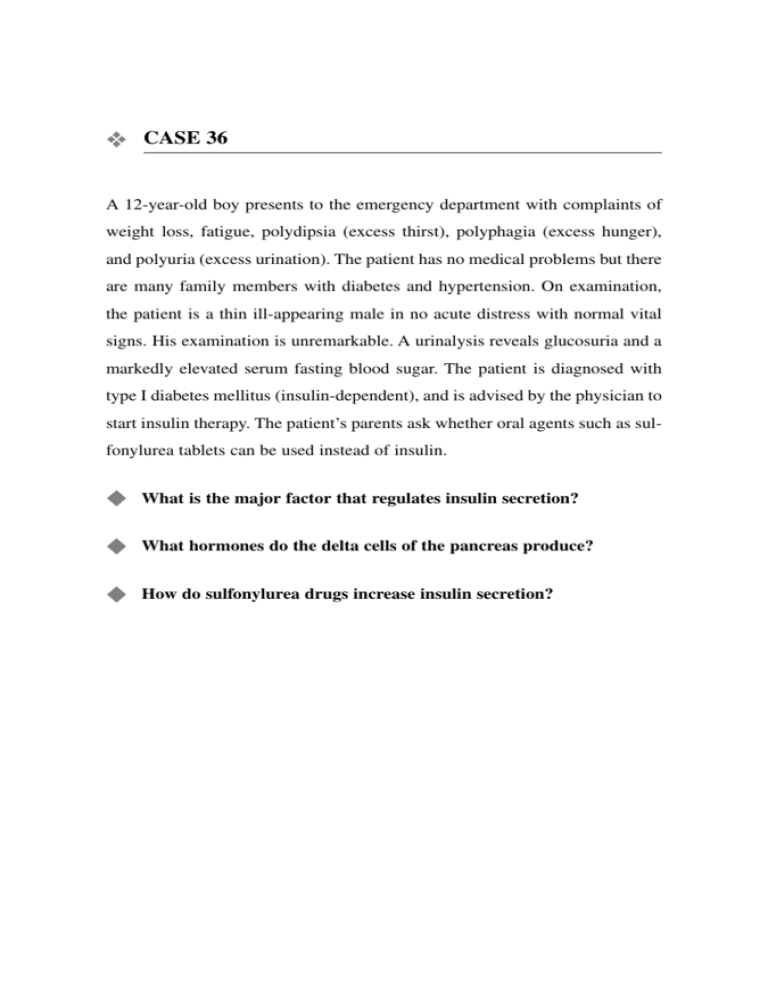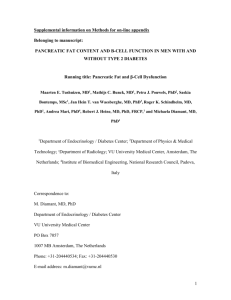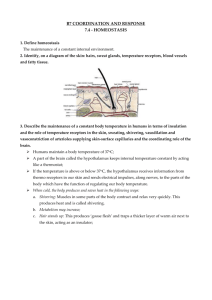Pancreatic Islet Cells
advertisement

❖ CASE 36 A 12-year-old boy presents to the emergency department with complaints of weight loss, fatigue, polydipsia (excess thirst), polyphagia (excess hunger), and polyuria (excess urination). The patient has no medical problems but there are many family members with diabetes and hypertension. On examination, the patient is a thin ill-appearing male in no acute distress with normal vital signs. His examination is unremarkable. A urinalysis reveals glucosuria and a markedly elevated serum fasting blood sugar. The patient is diagnosed with type I diabetes mellitus (insulin-dependent), and is advised by the physician to start insulin therapy. The patient’s parents ask whether oral agents such as sulfonylurea tablets can be used instead of insulin. ◆ What is the major factor that regulates insulin secretion? ◆ What hormones do the delta cells of the pancreas produce? ◆ How do sulfonylurea drugs increase insulin secretion? 294 CASE FILES: PHYSIOLOGY ANSWERS TO CASE 36: PANCREATIC ISLET CELLS Summary: A 12-year-old boy with weight loss, fatigue, polydipsia, polyphagia, polyuria, and elevated fasting blood sugar is diagnosed with type I diabetes mellitus. ◆ ◆ ◆ Major regulating factor: Serum sugar levels. Delta cells produce: Somatostatin and gastrin. Sulfonylurea medications: Close the KATP potassium channels in the beta cells allowing activation of voltage dependent Ca2+ channels resulting in insulin secretion. CLINICAL CORRELATION Type I diabetes (juvenile) is caused by destruction of pancreatic islet cells, leading to insulin deficiency. The destruction of the pancreatic islet cells may have multifactorial causes, such as genetic predisposition, viral, or autoimmune. Patients usually present in childhood or early adulthood and account for about 10% of all cases of diabetes. These patients’ symptoms include polydipsia, polyphagia, weight loss, and recurrent infections. Severe derangements may induce diabetic ketoacidosis, characterized by markedly elevated blood sugar levels, elevated serum ketone levels, metabolic anion gap acidosis, and a variety of metabolic derangements such as hypokalemia. A fasting blood sugar will help make the diagnosis of diabetes. Because the primary deficit is lack of insulin, patients will need insulin replacement to improve their symptoms. Oral agents usually cannot be used as primary therapy in type I diabetes because of the basic defect caused by insulin deficiency. Type II diabetes occurs because of peripheral tissue resistance to insulin. APPROACH TO PANCREATIC PHYSIOLOGY Objectives 1. 2. 3. Understand glucagon secretion, action, and regulation. Understand insulin secretion, action, and regulation. Understand somatostatin secretion, action, and regulation. Definitions Islets of Langerhans: Highly vascularized and innervated structures in the pancreas containing three major cell types that secrete insulin (beta cells), glucagon ( alpha cells) and somatostatin (delta cells). Insulin: A small polypeptide anabolic hormone that promotes the sequestration of carbohydrate, fat and protein mainly in liver, adipose tissue and skeletal muscle. In the absence of insulin these substances are mobilized from tissues to meet the fuel demands of the body. CLINICAL CASES 295 Glucagon: A small polypeptide hormone that targets mainly the liver to promote glucose production through gluconeogenesis and glycogenolysis, and fatty acid oxidation with the production and release of keto acids to meet the energy demands of the body during periods of fasting. Sulfonyl ureas: A class of small therapeutic molecules that are potent stimulants of insulin secretion by pancreatic beta cells. DISCUSSION The cells of the islets of Langerhans in the endocrine pancreas are the site of synthesis and secretion of the peptide hormones glucagon, insulin, and somatostatin. The islets are highly vascularized, with a blood flow pattern that drains directly into the portal vein, delivering the hormones directly to the liver. The islets are innervated in the areas of the secretory cells with both sympathetic (middle splanchnic nerve) and parasympathetic (vagus nerve) input. Mechanism of Secretion A general model applies to the mechanism of secretion for each of the three hormones, but the specific stimuli vary. The hormones are synthesized on the rough endoplasmic reticulum (ER) as propeptide hormones. They are processed in the ER and transported to the Golgi apparatus for sorting and packaging into secretory vesicles. Secretory vesicles bud off of the transGolgi network and are directed toward the plasma membrane. The vesicles containing the prohormone and the hormone-converting enzyme accumulate in proximity to and just below the plasma membrane. After the appropriate stimulus, the vesicles are recruited to the cell surface, where they fuse with the plasma membrane, and their contents are ejected from the cell. During this process of degranulation, there is a conversion to the hormone by specific enzymatic cleavage of the prohormone. The specifics of the activation of the secretory process are more fully characterized for insulin than for the other hormones. The mechanism is clinically relevant because it is the site of therapeutic intervention to increase insulin secretion from the beta cells. Insulin secretion is dependent on a rise in the intracellular calcium concentration according to the following sequence of events: 1. 2. 3. 4. The main stimulus is an increase in the plasma glucose concentration that causes an increase in intracellular glucose. Increased glucose in the cell promotes an increase in adenosine triphosphate (ATP) levels. ATP inhibits a potassium channel in the plasma membrane, with a resultant depolarization of the membrane potential. Depolarization of the membrane activates a voltage-dependent calcium channel, permitting calcium influx and the initiation of secretory vesicle fusion. 296 CASE FILES: PHYSIOLOGY The importance of this sequence of events is underscored by the finding that the potassium channel is blocked by sulfonylureas. Thus, therapeutic use of these agents can enhance insulin secretion in patients with an insulindeficient or resistant disease. Regulation of Secretion There is a complex physiologic interaction between insulin and glucagon that is reflected in their regulation and mechanism of action. Generally, factors that result from stresses to the individual, such as starvation and low plasma glucose and elevated levels of epinephrine, norepinephrine, cortisol, or growth hormone all stimulate glucagon secretion and suppress insulin secretion. During unstressful periods with adequate food, metabolic factors such as carbohydrates, fatty acids, and amino acids stimulate insulin secretion. Insulin Insulin is an anabolic hormone that promotes the utilization and storage of glucose, fatty acids, and amino acids. Insulin is secreted by the beta cells of the islet in response to numerous stimuli, including metabolites, hormones, and neural mediators. The most important regulator of insulin secretion is the plasma glucose concentration. Increasing plasma glucose causes a stimulation of insulin secretion, whereas a fall in glucose is accompanied by a decline in insulin secretion. Regulation of insulin secretion by other factors such as amino acids, fatty acids, and ketone bodies for the most part is a complex interaction and is dependent on the circulating level of glucose and not relevant to the present case. Insulin secretion is stimulated by several hormones. There is a class of hormones called incretins that are mainly enteric hormones that stimulate insulin secretion. Interestingly, these hormones are secreted in response to the ingestion and absorption of carbohydrate, protein, or lipid and are secreted in advance of an increase in the circulating levels of the metabolites. The insulin response is thus anticipatory of the increase. The ultimate effect is to enhance insulin secretion by the beta cells. In the experimental setting, there are several hormones that exhibit this response; however, the physiologically relevant agents are glucose-dependent insulinotropic peptide (GIP) and glucagonlike peptide-1 (GLP-1). A paracrine effect of glucagon is to stimulate insulin secretion, presumably to potentiate the effect of glucagon on the elevation of plasma glucose levels. Secretion of insulin also is enhanced by cortisol and growth hormone. Somatostatin inhibits insulin secretion through a paracrine effect. The islets are innervated with both sympathetic and parasympathetic neurons. The beta cells are stimulated by the parasympathetic release of acetylcholine or vasoactive intestinal peptide (VIP). The sympathetic hormones, epinephrine and norepinephrine, are potent inhibitors of insulin secretion. A strong sympathetic response can shut down insulin secretion CLINICAL CASES 297 completely, thereby minimizing glucose utilization as part of the flight or fight response. The role of insulin is to promote the storage of metabolic fuels in the form of glycogen, triglyceride, and protein. The main targets of insulin action are the liver, muscle, and adipose tissue. The mechanism of action of insulin is complex, eliciting both rapid responses and longer term effects on cell metabolism. Insulin action is mediated by a plasma membrane insulin receptor that is one of the tyrosine kinase receptors that can activate multiple intracellular signaling pathways (see Case 2). In the short term, the effects of insulin on the cell are increased glucose transport (adipose and muscle), glycogen synthesis, and fatty acid synthesis. In the long term, a parallel pathway involving MAP kinase activation leads to the activation of transcription factors that regulate specific protein synthesis. Glucagon Glucagon is produced and secreted by the alpha cells of the islets, although the regulation and mechanism of secretion are not clearly understood (see above). As is the case with insulin secretion, the most important determinant in the secretion of glucagon is the blood glucose concentration. However, the rate of glucagon secretion decreases with increasing blood glucose. Glucagon secretion is maximal at plasma glucose concentrations less than 50 mg/dL and completely blocked at concentrations above 200 mg/dL. A comparison of several effectors on glucagon secretion by the alpha cell shows that the response is the opposite of the effect on beta-cell secretion of insulin. In addition to glucose, ketone bodies and free fatty acids inhibit glucagon secretion. The enteric hormones GIP and GLP-1 that stimulate insulin secretion inhibit glucagon secretion. Finally, insulin itself and somatostatin inhibit glucagon secretion. Alpha cells also secrete glucagon in response to neural stimulation from both sympathetic and parasympathetic neurons. In contrast to the beta cell, epinephrine and norepinephrine are potent stimuli for glucagon secretion, as are acetylcholine and VIP from parasympathetic neurons. The major target tissue for glucagon is the liver, and in most regards glucagon is counterregulatory to insulin action. The mechanism of glucagon action is very well defined and well described. Although glucagon receptors are found on other tissues, the concentration of the hormone necessary to elicit a response is well above the physiologic range. The hepatic glucagon receptor is a G protein–coupled receptor. Binding of glucagon leads to activation of adenyl cyclase and synthesis of cyclic adenosine monophosphate (cAMP). Elevated cAMP activates protein kinase A, resulting in the phosphorylation of a number of key regulatory enzymes. The result is a stimulation of glycogen breakdown and gluconeogenesis with a net production and release of glucose into the blood. During periods of fasting (low circulating levels of insulin) glucagon will also limit fatty acid synthesis and promote its breakdown and production of ketone bodies. 298 CASE FILES: PHYSIOLOGY Control of the Plasma Glucose Concentration The opposing actions of insulin and glucagon on hepatic function are the basis of a simple but elegant feedback mechanism to control net glucose production. The key regulator of pancreatic secretion of insulin and glucagon is the plasma glucose concentration, which is controlled by the action of these two hormones on the liver. As plasma glucose concentrations approach fasting levels below 90 mg/dL, glucagon secretion increases and insulin secretion decreases. These changes promote the production of glucose in the liver and its release into the blood. Somatostatin Pancreatic somatostatin is secreted by the delta cells of the islets. The role of pancreatic somatostatin is poorly understood. From a number of experimental studies, somatostatin has been shown to inhibit both alpha-cell and beta-cell secretion of glucagon and insulin, respectively, suggesting a possible paracrine role for the hormone. COMPREHENSION QUESTIONS [36.1] Insulin secretion is inhibited by which of the following? A. B. C. D. [36.2] An experimental animal is instrumented to monitor plasma glucose and insulin levels. After a control fasting period to establish a steady state, a test substance is administered to the animal. Shortly after the administration of the substance, there is an increase in the plasma insulin concentration and a fall in the plasma glucose concentration. The substance is most likely which of the following? A. B. C. D. E. [36.3] Glucagon Epinephrine Amino acids Glucose Glucagon Epinephrine A sulfonylurea compound Somatostatin Glucose In a normal individual, the liver is the main regulator of the plasma glucose concentration. When there is an increase in the plasma glucose concentration, the liver extracts glucose from the blood and converts it into glycogen and, to a lesser extent, triglycerides. When the plasma glucose concentration falls, the liver will begin to produce glucose and release it into the blood to maintain its concentration. In an untreated type I diabetic patient, the liver fails to extract glucose and continues to produce glucose regardless of its plasma concentration. Which of the following most likely contributes to this failure? CLINICAL CASES A. B. C. D. E. 299 Increased glucokinase activity Decreased phosphorylase activity Increased gluconeogenesis Diminished muscle protein catabolism Insulin-dependent glucose transport in the liver Answers [36.1] B. Insulin secretion is stimulated by amino acids and glucose and inhibited by somatostatin and epinephrine and sympathetic stimulation. Epinephrine is a potent blocker of insulin secretion and stimulates glucagon secretion. This is the so-called flight or fight response to provide a burst of glucose for rapid and immediate utilization. [36.2] C. The correct answer is a sulfonylurea compound. These compounds block the ATP-inhabitable K+ channel in the beta cells, which causes a depolarization and activation of a Ca2+ channel. The influx of Ca2+stimulates insulin secretion. As insulin levels rise, there is increased glucose utilization by liver, muscle, and adipose tissues, causing a fall in the plasma glucose concentration. Glucagon or glucose would stimulate insulin secretion; however, there would be a transient increase in the plasma glucose concentration. Epinephrine and somatostatin would inhibit insulin secretion. [36.3] C. The liver has no insulin-dependent glucose transport system. Glucose transport is insulin-independent, and glucose rapidly equilibrates across the hepatocyte membrane. One of the most important factors in the failure of the liver to extract glucose in a chronically insulin-deficient state is reduced glucokinase activity. Glucokinase is liver-specific and has several important features that distinguish it from the analogous hexokinase in other cell types. It also has a higher Km and is not feedback-inhibited by its product glucose-6-phosphate. Therefore, even at high glucose concentrations, glucokinase does not saturate and continues to produce glucose-6-phosphate, which can accumulate in the cell. Insulin has a permissive effect on glucokinase, and in its absence, glucokinase levels can fall to very low levels. As a consequence, glucose entry into the glycolytic or glycogen synthetic pathway is limited. The lack of insulin also reduces the activities of key regulatory enzymes (eg, glycogen synthase, phosphofructokinase, and pyruvate kinase) involved in directing glucose toward glycogen synthesis or glycolysis, further limiting glucose utilization. Insulin also promotes protein synthesis in muscle tissue, and in its absence, there is an increased protein catabolism with a release of glucogenic precursors into the blood. These precursors are taken up by the liver and used to produce glucose through the gluconeogenic pathway. 300 CASE FILES: PHYSIOLOGY PHYSIOLOGY PEARLS ❖ ❖ ❖ ❖ ❖ ❖ ❖ The major hormones regulating energy metabolism are glucagon and insulin. They are produced and secreted by the alpha and beta cells of the pancreatic islets of Langerhans. Insulin is an anabolic hormone that targets the liver, adipose tissue, and muscle tissue and promotes glycogen synthesis, fatty acid synthesis and triglyceride formation, and protein synthesis. Glucagon targets the liver and is counterregulatory to insulin, promoting glycogenolysis, fatty acid oxidation, and gluconeogenesis. Glucagon action is mediated by G protein–coupled plasma membrane receptor activation of adenyl cyclase and protein kinase A activation. Insulin targets mainly the liver, muscle, and adipose tissues, and its action is mediated by a plasma membrane tyrosine kinase receptor and has short-term and long-term effects on the target cell. The immediate effects are the activation of protein kinase B and phosphoprotein phosphatase-1, which antagonize cAMP-dependent reactions and promote glycogen synthesis, fatty acid synthesis, and triglyceride formation. Longer term insulin effects are mediated by the MAP kinase signaling pathway, with activation of specific transcription factors that leads to increased protein synthesis. During starvation, there is a dramatic fall in insulin levels, leading to a decrease in insulin-dependent processes and allowing glucagon-dependent processes to prevail. The fall in plasma glucose stimulates glucagon secretion, which promotes hepatic fatty acid oxidation, glycogen breakdown, and gluconeogenesis. The lack of insulin allows protein breakdown to occur, with a release of glucogenic precursors from muscle into the circulation. Glucagon-dependent gluconeogenesis from these precursors in the liver is driven by energy derived from fatty acid oxidation. REFERENCE Goodman HM. The pancreatic islets. In: Johnson LR, ed. Essential Medical Physiology. 3rd ed. San Diego, CA: Elsevier Academic Press; 2003:259-276.







